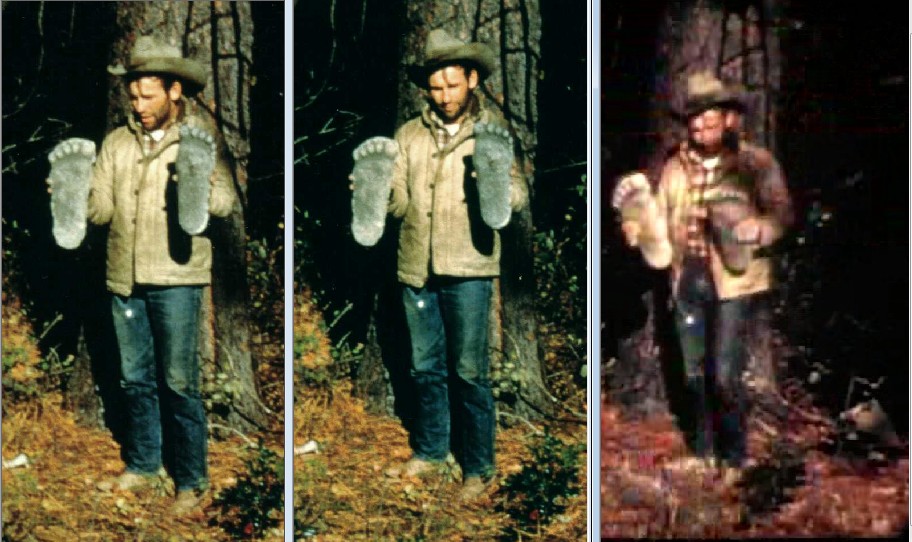
Roger Patterson (above), as you will recall, was born in Wall, South Dakota on February 14, 1933, and died of cancer on January 15, 1972.
October 20, 2009
Tuesday, October 20, 2009, marks the 42nd year since the now famous so-called Patterson-Gimlin Bigfoot film footage was taken at Bluff Creek, California.
Needless to say, it was on this very day, in 1967, that Roger Patterson and his field partner, Bob Gimlin, filmed what still to me appears to be a female Bigfoot walking alongside Bluff Creek, located in the Six Rivers National Forest of northern California. One cannot seriously study the subject of Sasquatch without being familiar with this footage.
But, of course, behind the camera were men. And men are only human, with human failings.

Roger Patterson (above), as you will recall, was born in Wall, South Dakota on February 14, 1933, and died of cancer on January 15, 1972.
Bob Gimlin is still with us. The genuine gentleman, Gimlin, has been pushed to the forefront, as far as becoming a reluctant spokesperson, who only first began coming to conferences on hominology and Sasquatch studies in 2003.
I happily got to appear at another Bigfoot conference recently with Bob Gimlin, during the gathering in Texas in September 2009. Since I am an early bird, and actually, because most people were sleeping in late, I would find myself down in the lobby eating early light breakfasts almost always alone. It happened twice that only one other person was there, and that was Bob Gimlin.
Naturally, Bob and I shared a table and conversations. We had a great time swapping stories about Ivan Sanderson, Roger Patterson and the good old early days of Bigfoot hunting and the other personalities involved. Sometimes I talked, but more often than not, I enjoyed intensively listening to what Bob wished to say and asked a few pointed questions.
One thing that has always interested me is how the whole situation was handled after the October 20th filming. The fact there were people involved resulted in the addition of the “human element.” This caused the usual tendency of people to muck things up. Of course, this is the human factor that enters into just about any field of strong egos and groundbreaking discoveries, often characterized, for example, in anthropology with phrases like “bones of contention.”
During my early morning talks with Bob Gimlin, he shared with me, for the record, a story that I do not recall having ever heard before. It involved a little schism that developed between Patterson and Gimlin, and the hard feelings that resulted thereafter for the two men.
Bob and I were discussing the confusion that sometimes occurs with people mixing up who is who in the field. Bob then stopped me short by sharing a startling turn of events he once found out about, regarding his buddy Roger.
It was a couple years or so after the film had been taken, and Bob got a call from a friend of his with a strange tale. It seems the friend heard about a talk on Bigfoot, which was to take place in a little hall in a Southwestern town near where the guy lived. It happened to be a road appearance by Roger Patterson, who was taking around the raw footage and showing it for a little admission price on a haphazard lecture circuit.
The talk and film were interesting, the friend told Gimlin, but it was what occurred next that really got the guy a bit hot under the collar.
All of a sudden, in an apparently scripted scenario, after Patterson showed the Bigfoot film, up on the stage strolled out a man dressed like a Western ranchhand. To the friend’s and most of the audience’s surprise, the cowboy introduced himself: “Hi everyone. I’m Bob Gimlin and I saw the Bigfoot too, like Roger did. I was there.”
Bob Gimlin’s friend said that he felt like standing up and yelling out something like, “Hey, damn it, I know Bob Gimlin and that’s not Bob Gimlin.”
Instead of a confrontation, the friend decided to call up Bob about what he had just witnessed with his own eyes with this staged act.
Bob, a quiet man, never pressed Roger on it, but the two grew apart. And Bob waited.
It wasn’t long before Roger Patterson’s health started to decline, and dying, Roger called Bob to his bedside. Weak, obviously near death, and apparently wanting to die with a clean slate, Gimlin told me that Roger said to him, “Bob, we did you wrong. I shouldn’t of had that fella act like he was you. I did wrong.”
Both men only had a few words about it, and that was it. Soon Patterson was gone. Bob Gimlin thought it was an apology, and he was sad to see his old friend die. He really never held it against Patterson, but just thought it was not a “right thing to do.”
Gimlin only let go of his upset about the “bad blood” after Patterson called him to his bedside as he was dying, for that little talk.
So, yes, Roger Patterson did once give a “deathbed confession,” but it never had a thing to do with faking the film. It only was about Patterson having used a fill-in “Bob Gimlin” because the real Bob Gimlin had a horse business and family that never allowed him to get away to go on the lecture circuit. Besides, Gimlin hated public speaking back then (and really still does, he told me).
Is it something that Patterson shouldn’t have done? Of course it is.
Did doing what Patterson allegedly did during his lectures mean that he faked the footage itself? No.
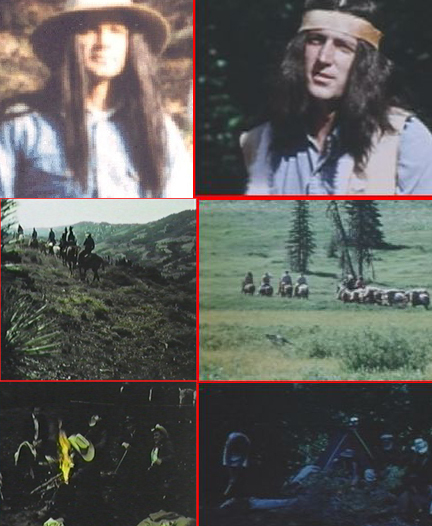
The images on the right in this montage are from the docudrama Sasquatch, the Legend of Bigfoot. The top left image is Bob Gimlin; the top right image is “Techka Blackhawk,” played by Joe Morello from the movie. The images on the left are of the real people and are here compared to the docudrama’s frame captures of the fictional actors and scenes.
This docudrama was Joseph A. Morello’s only acting job, ever. He was born in Springfield, Massachusetts, on July 17, 1929. He went blind in 1967, and apparently remains alive today. He appeared on over 120 albums and CDs, of which 60 were with the Dave Brubeck Quartet (1956-1967) and three with legendary guitarist Hank Garland, including the landmark album Jazz Winds From a New Direction.
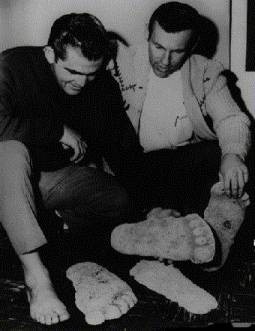
Bob Gimlin and Roger Patterson look over the casts from the 1967 filmsite.
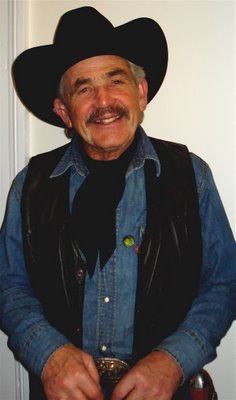
Bob Gimlin, 2008.
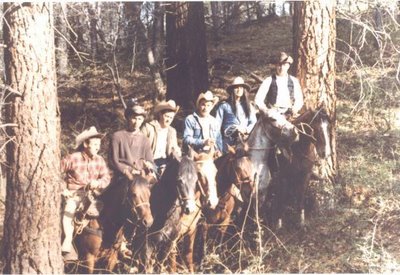
On the left, in the checkered shirt, is Roger Patterson. The man, second from the right end, with the long hair, is Robert Gimlin, who is part Native.
I don’t know what Bigfoot/Sasquatch are, but I know that Roger Patterson and Bob Gimlin are only human.
VVVVVVVVVVV
An additional comment:
This morning, after reading this, John Green wrote me, saying: “Didn’t know about the confession, but the substitution is an old story.”
Well, yes.
While I did not overtly say it, the entire reason I wanted to put this on the record is to make the point that for those debunkers who talk about a rumored Patterson “deathbed confession” about any fakery, it was about the substitution, not about the film being a fake!!
The Bluff Creek Bigfoot articulo mortis does exist.
_________
Celebrate the day and donate to a good cause, preserving Bigfoot history and artifacts in an educational and scientific museum setting:
Please click on the button below (not the one up top) to send in your museum donation.
Thank you!
About Loren Coleman
Loren Coleman is one of the world’s leading cryptozoologists, some say “the” leading living cryptozoologist. Certainly, he is acknowledged as the current living American researcher and writer who has most popularized cryptozoology in the late 20th and early 21st centuries.
Starting his fieldwork and investigations in 1960, after traveling and trekking extensively in pursuit of cryptozoological mysteries, Coleman began writing to share his experiences in 1969. An honorary member of Ivan T. Sanderson’s Society for the Investigation of the Unexplained in the 1970s, Coleman has been bestowed with similar honorary memberships of the North Idaho College Cryptozoology Club in 1983, and in subsequent years, that of the British Columbia Scientific Cryptozoology Club, CryptoSafari International, and other international organizations. He was also a Life Member and Benefactor of the International Society of Cryptozoology (now-defunct).
Loren Coleman’s daily blog, as a member of the Cryptomundo Team, served as an ongoing avenue of communication for the ever-growing body of cryptozoo news from 2005 through 2013. He returned as an infrequent contributor beginning Halloween week of 2015.
Coleman is the founder in 2003, and current director of the International Cryptozoology Museum in Portland, Maine.
Filed under Bigfoot, Cryptomundo Exclusive, CryptoZoo News, Men in Cryptozoology, Public Forum, Sasquatch, Year In Review